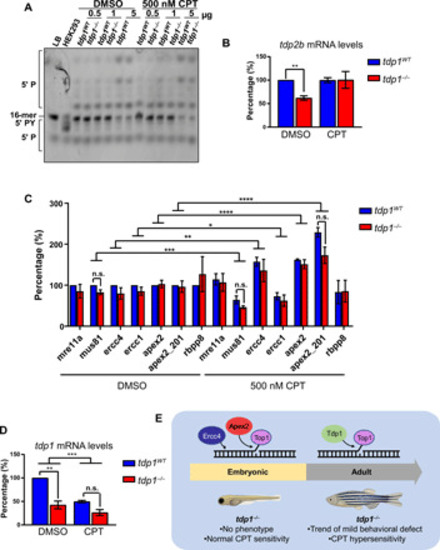|
Tdp1 is not required for Top1-CC repair in zebrafish embryos.(A) Four-dpf zebrafish were treated with 500 nM CPT overnight, and lysates were incubated with a 3′ labeled oligonucleotide with a 5′-phosphotyrosyl (PY). TDP2 processes the phosphotyrosyl moiety into a phosphate group, resulting in a lower band on a DNA sequencing gel. We noted bands that are higher than the original substrate, which suggest further repair events taking place using the zebrafish lysate. Lysis buffer (LB) was used as a negative control and human embryonic kidney (HEK) 293 cell lysate as a positive control. (B to D) Four-dpf zebrafish embryos were treated with 500 nM CPT overnight, and total RNA was processed by reverse transcription qPCR (RT-qPCR). Transcript levels normalized to rps29 are shown; three biologically independent experiments, ±SEM. P values, two-way analysis of variance (ANOVA) with Holm post hoc analysis for multiple comparisons. (E) A model for the requirement of distinct DNA repair factors for Top1-CC repair during the zebrafish life span. We propose that during embryonic development, zebrafish use Apex2 and Ercc4 to repair Top1-induced DNA breaks. During adulthood, however, Tdp1 becomes essential for repairing Top1-CCs, and thus, tdp1−/− fish develop a mild behavioral defect and CPT hypersensitivity in adulthood but not at embryonic stage. *P < 0.05; **P < 0.01; ***P < 0.001; and ****P < 0.0001.
|

